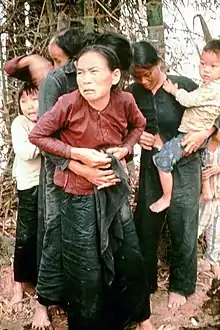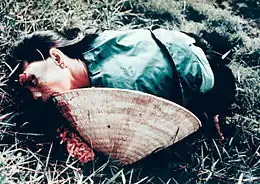Women in the Vietnam War
During the Vietnam War, nearly 11,000 Vietnamese women and over 5,000 American women served in Vietnam itself.

The roles of Vietnamese women

There is relatively little data about female Vietnam War veterans. The VMF (Vietnam Women’s Memorial Foundation) has estimated that around 11,000 Vietnamese women served their country during the Vietnam War, all of which were likely volunteers.[1] They served in a variety of roles, but most of the women serving in South Vietnam were trained as nurses and government office clerks. For the Viet Cong women, they usually worked as truck drivers or were sent across the border to smuggle goods and equipment.[2] A number of civilian Vietnamese women also served as volunteers for the Red Cross, Catholic Relief Services or other humanitarian organisations. While Vietnamese women were active in combat, particularly women in the Viet Cong, the women most impacted were the civilian casualties.

One infamous and horrific attack on civilian women occurred in March 1968 – the My Lai massacre. Over 500 unarmed men, women and children were mercilessly slain in the hamlet of Sorn Tinh (South Vietnam) by American Soldiers. Women and young girls were first raped and tortured by groups of American soldiers before being killed.[3] The cause of the Vietnam War started out as essentially a civil war, the North against the South. Northern Vietnam was run by a Communist government, lead by Ho Chi Minh. In order to gain popularity and enhance social equity, the North Vietnamese Government imposed new laws banning wife-beating, forced marriages and child marriages.[1] In addition, they also focused on the roles of women outside of the traditional home for the purpose of industrial growth and development. As a result of this, North Vietnamese women were seen as essential participants, and were enlisted into the Viet Cong for the purposes of combat and manual labour. Smaller, more nimble women were often sent into the combat zone to lay booby-traps and to spy on the American’s and the South Vietnamese army.[1] For the purposes of manual labour, many women were sent to work and manage the Ho Chi Minh trail to ensure that food, supplies and heavy artillery had clear passage. In addition, North Vietnamese women worked in rice fields in both North Vietnam and Viet-Cong held farming areas in the South in order to provide food and shelter for advancing Viet Cong forces.
During the war, the Vietnamese men were losing morale. The military decided that they would recruit women who had been youth volunteers before to drive truck loads of soldiers up and down the Ho Chi Minh trail while American pilots were dropping bombs from the sky. The purpose of this was to show the male soldiers that if women can do it, you can stick it out [4]
In addition, Vietnamese civilian women were subject to further sexual assaults during the breadth of the conflict, and much like the Korean War, they were used as “comfort women” and prostitutes. In 1990, the Korean Council for the Women Drafted for Military Sexual Slavery was established by nearly 40 progressive women’s rights organisations in order to address the issue of comfort women and sex slaves kept for the Imperial Japanese Army.[5] Over time, the council pledged that its long-term goal is to review all historical instances of sexual slavery within militaries to prevent any further sexual abuse of women during wartime. In March 2012, on International Women’s Day, the council established the Butterfly Fund – a not for profit organisation that helps women who have been used and abused by military forces in times of war.[5] Since its establishment, the fund had been providing support to victims of sexual violence in the Congo Civil War and the children born as a result of that violence.[6] In 2013, the fund began its campaign to support the women assaulted in the Vietnam War. The Butterfly Fund’s symbol – a butterfly – represents the hope of sexual assault survivors and the hope of other women that women will be freed from oppression, discrimination and violence and that one day all women and girls will be free to spread their wings.[7]
The roles of American women

The majority of the American women that served in Vietnam were trained, graduate nurses. Most were fresh out of college and had volunteered their service, while other, more experienced nurses were sent to Vietnam to assist in training many South Vietnamese women.[8] The first group of the Army Nurse Corps arrived in Vietnam in 1956, and by 1973 nearly 5000 American women would be serving in Vietnam. Only five of them died during the war, two of which were posthumously awarded bravery medallions – Lieutenant Colonel Annie Ruth Graham had previously served in World War II and the Korean War while First Lieutenant Sharon Lane had previously served in Korea. Graham died in 1968 after suffering a stroke, and Lane died shortly after from injuries sustained after an attack on the hospital where she had been stationed.[9] Lane was later also awarded a posthumous Vietnamese Gallantry Cross with Palm and the Vietnamese Bronze Star for Heroism.[9]
In addition to on the ground nurses, there were some women who served as Naval and Air Force Nurses. The first members of the U.S. Navy Nurse Corps arrived in Saigon in 1963, and were awarded the Purple Heart after they were injured during a Christmas Eve bombing in Saigon by the Viet Cong.[1] They were the first female Americans to be awarded for their bravery. During the Vietnam War, eight WAF (Women’s Airforce) Nurses died during conflict. During the Vietnam War, there were only nine women who served in a role other than a nurse, including Lieutenant Elizabeth Wylie, who worked as a Commander of Naval Forces in the Vietnam Command Information Centre alongside Commander Elizabeth Barret who become the first female naval line officer to hold command in an official combat zone.[1]
Women of other nationalities

Other than American and Vietnamese women, a small number of Australian nurses were stationed in Vietnam, while non-medically trained women were sent to volunteer with the Red Cross and other humanitarian organisations. In addition to Australia, Canada sent a significant amount of re-enforcements to Vietnam on behalf of the Americans. By the end of the war, some 30,000 Canadian citizens had volunteered their service, and nearly 140 of them had been killed in action.[10] It is unknown how many of these 30,000 were women, but not all 30,000 had directly served in combat. Canada’s main role during the conflict was for the purposes of peacekeeping and monitoring the cease-fire agreements made during the Paris Peace Conference.
References
- "Women in the Vietnam War". HISTORY.
- Editors. "Women in the Vietnam War". HISTORY.CS1 maint: extra text: authors list (link)
- Ngai, Quang. "Unidentified Vietnamese Women and Children in My Lai". Vintage Everyday.
- Nguyen, Hanh (2017-09-26). "'The Vietnam War': How Vietnamese Women Saw Combat and Got Involved in Other Harrowing War Efforts". IndieWire. Retrieved 2020-07-28.
- "The reality of war and violence". History's Shadow.
- "Vietnamese War victims speak of sexual violence".
- "Vietnamese War victims speak of sexual violence". Hankyoreh.
- "Women in the Vietnam War". History.
- Wills, Barbara. "American Women died in Vietnam too". The Conversation.
- "The Vietnam War: Canada's Role". CBC.
